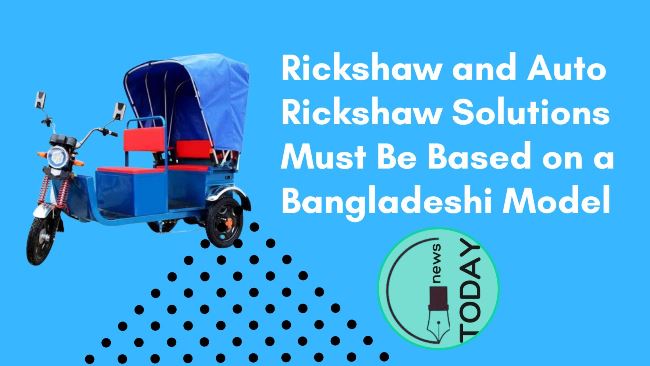Bangladeshi Model: The Key Solution for Rickshaw and Auto-Rickshaw Issues

Rickshaw and Auto Rickshaw Solutions Must Be Based on a Bangladeshi Model
A pedestrian was shot during a protest against the government’s directive to stop battery-operated rickshaws and auto rickshaws in the Kalshi area of the capital. Media reports state that Sagar Mia, a 22-year-old, was injured by police fire during a clash with auto rickshaw drivers. Protesters set fire to a police box during the demonstration, which involved blocking roads in Mirpur-1, 10, and Agargaon, demanding permission to operate battery-powered rickshaws. This led to severe traffic congestion throughout Mirpur. After the blockade, police allowed buses to pass on one side, resulting in agitated auto rickshaw drivers vandalizing several buses with sticks and bricks. However, there is some relief, as Awami League General Secretary and Minister of Road Transport and Bridges Obaidul Quader announced today (May 20) that Prime Minister Sheikh Hasina has instructed to allow battery-operated rickshaws in Dhaka city, considering the needs of low-income people. However, he also mentioned that battery-operated rickshaws would remain banned on 22 national highways.
This incident raises several questions:
- Why did the government suddenly decide to ban battery-operated auto rickshaws in the capital?
- What will happen to the foot-operated rickshaws that have already been converted into auto rickshaws?
- If auto rickshaws are declared illegal now, how did thousands of rickshaws become auto rickshaws in front of the administration’s eyes, and why have they been allowed on the roads until now?
- The number of foot-operated rickshaws has decreased due to the presence of auto rickshaws, both in the capital and throughout the country. Was there any consideration given to the severe shortage of vehicles that would arise from suddenly banning auto rickshaws and the resulting public inconvenience?
- Auto rickshaws were introduced as an alternative to traditional rickshaws. What is the alternative if auto rickshaws are banned now?
The government’s decision to ban auto rickshaws is primarily aimed at preventing accidents. The high court has also issued directives on this issue. Former Minister of Road Transport and Bridges Obaidul Quader stated, “The main cause of road deaths in our country is motorcycles and auto rickshaws. An auto rickshaw can carry 7 to 8 people. In an accident, everyone in the auto rickshaw can die. Motorcycles are another menace.”
The minister referred to the issue of e-rickshaws, which have become a significant concern on highways. Most drivers of these slow-moving vehicles are untrained and lack licenses.
Related You Might Like
How to Choose Your First Electric Bike?
Many previously drove rickshaws and took loans to buy e-rickshaws after leaving agricultural work or other day labor. While they have facilitated transportation in suburban and urban areas, their illegal entry onto highways has also increased accidents.
Pedal Rickshaws Are Now Electric!
The discussion in Dhaka revolves around auto rickshaws, particularly those that were originally pedal rickshaws and have now been converted. These rickshaws are not designed to carry more than two passengers. Thus, pedal rickshaws are effectively transitioning to electric. The only difference is that they now use a machine. Reports indicate that these auto rickshaws do not often get into accidents on narrow streets and alleys.
However, some auto rickshaw drivers drive recklessly and often compete with private vehicles. In such cases, the passengers’ awareness can make a difference. If a passenger requests the driver to drive carefully and slowly, or insists on it, this competitive mentality can gradually decrease. Therefore, banning auto rickshaws in Dhaka due to accident concerns is not a viable option. If that were the case, there should be clear statistics showing the accident rates of foot-operated rickshaws that have been converted into auto rickshaws.
Will Legitimizing Them Through Policy Bring Control?
Another significant complaint against auto rickshaws is electricity waste. It is argued that when there is an electricity crisis in the country, with prolonged load shedding in many areas, the charging of these auto rickshaw batteries consumes a lot of electricity. The question arises: is the amount of electricity used by auto rickshaws truly wasteful? This electricity is circulating back into the economy. It provides livelihoods for a vast number of people and makes transportation quicker and easier. Therefore, this argument cannot justify the ban on auto rickshaws; rather, there is an urgent need to increase electricity production and curb electricity theft and waste.
Commuting Costs Will Increase!
Another issue is that if battery-operated rickshaws are banned, the fare for pedal rickshaws will likely double. Over the past few years, most rickshaws have become battery-operated, resulting in a significant decrease in the number of pedal-operated rickshaws. The few remaining pedal rickshaw drivers will charge passengers double or triple the fare. Additionally, even with the increased fare, people will not receive rickshaws in a timely manner. Thus, shutting down battery-operated rickshaws without providing alternatives is not a solution but rather a way to increase public suffering.
On the day when auto rickshaw drivers protested in the capital, a parent named Sharmili Jahan wrote on Facebook: “Have all auto rickshaws been permanently banned everywhere? I have no idea. I faced immense difficulty taking my son to school in the scorching heat without any rickshaws.” Incidents like these will continue if auto rickshaws are banned.
Lawyer Mahbubul Alam wrote: “If battery rickshaws are present, it will not be possible to bring in any new battery transport.”
Therefore, it is crucial to understand why the government wants to ban auto rickshaws.
Former professor of economics at Chittagong University, Dr. Moinul Islam, raised the question of “What prevents the legalization of battery-operated auto rickshaws”.
Citing Accidents Is Not a Solution!
Citing accidents as a reason means no vehicle will be allowed to operate. Because if auto rickshaws do not go on highways and main roads, but only operate on small streets and alleys; if they do not drive recklessly, then there should be no concern about accidents. Rather, people’s transportation will be easier, time will be saved, and many will find employment.
When discussions arise about any problem on social media, many cite examples from Europe and America, stating that such vehicles are not present there. This mentality sometimes leads our politicians to say that Bangladesh will be turned into Singapore. Before making such absurd statements, they should consider the population of Singapore compared to Bangladesh, as well as the area size of both countries.
Comparing Bangladesh’s GDP
People often overlook that the size of the GDP and per capita income of the United States and the United Kingdom are significantly higher than Bangladesh’s. When debates arise over the price of beef, many without much thought state that in Norway, beef costs so much per kilogram. However, they fail to consider whether there is any basis for comparing the monthly income, social security, and standard of living of Norwegians with those of Bangladeshis.
Bangladesh is a Unique State
Bangladesh is a unique state in the world. More than 170 million people live in this small country, with about 25 million residing in its capital. Most countries do not have such a population in their entire region. Therefore, the traffic systems of Singapore, New York, London, and Oslo cannot be applied to Dhaka. The planning here must be tailored to Dhaka’s needs.
Solutions to Bangladesh’s problems must be sought based on its unique context. There is no opportunity to formulate transport plans for this city based on the experiences of Singapore, New York, or London. For a long time, there has been an effort to transform Dhaka into a city for the wealthy, which has resulted in the gradual banning of rickshaws on many roads.
Banning is Not a Solution
Rickshaws are completely banned on major roads. One of the main reasons for this is traffic congestion. When rickshaws share lanes with fast buses and private cars, it slows down the city’s pace. However, there is no room to ban rickshaws on small streets and alleys. Declaring any road outside the main thoroughfare as VIP and banning rickshaws there is not feasible. Instead, they must be brought under control. Reckless driving must stop. The government can also arrange for their training. A list should be created to determine how many rickshaws are needed in each area, ensuring that no more than that number operates on the roads. Therefore, auto rickshaws must be brought under licensing, and monitoring must be strengthened. It is essential to ensure that traffic police and local political thugs do not exploit these vehicles for illegal benefits. Above all, auto rickshaws cannot be banned without alternatives, leading to public inconvenience.
Pedal Rickshaws are Inhumane!
In defending auto rickshaws, many have labeled pedal rickshaws as “inhumane.” This is because one person pulls two others using their physical strength. This can sometimes be viewed as unethical. However, it is equally true that if driving a rickshaw is considered inhumane, many other jobs would fall into this category. For example, agricultural work requires immense labor. Traffic police work in sun, rain, and storm; women break stones; factory workers do heavy lifting—these jobs could also be seen as inhumane. Cleaners, especially those who work as sweepers, perform similar types of labor—shouldn’t we also consider their work?
Can we just eliminate these jobs?
If we take all this into account, we must devise a transportation system tailored to our needs and realities. If a proper transport plan is implemented, auto rickshaws can be brought under control while fulfilling the demands of the people.
Conclusion
It is evident that people have great demand for rickshaws in cities like Dhaka. Their convenience and affordability make them an integral part of urban transport. Therefore, it is crucial to find a balanced solution that addresses safety concerns without completely banning auto rickshaws. By implementing proper regulations, training, and a sustainable transport policy, we can create a safe and efficient urban transport system that serves the needs of all citizens while ensuring public safety and convenience.




